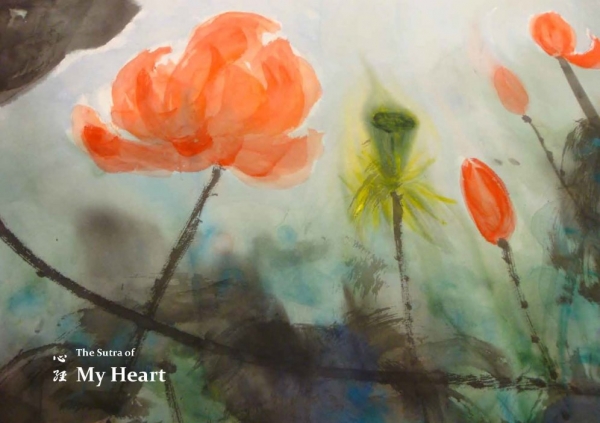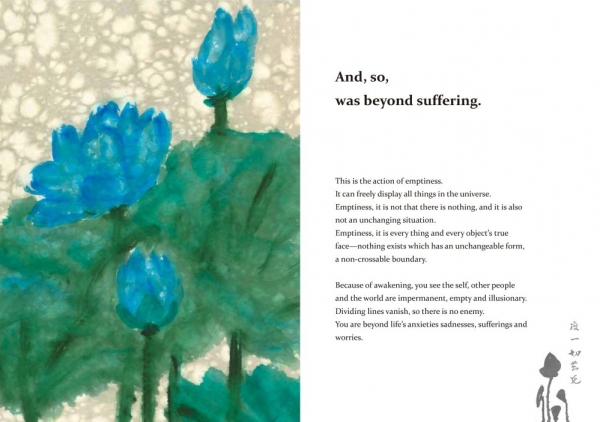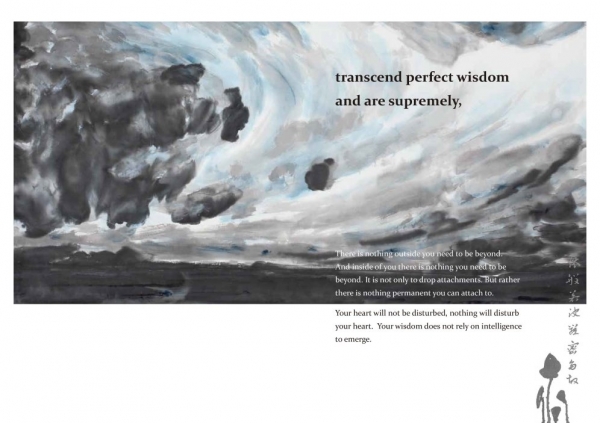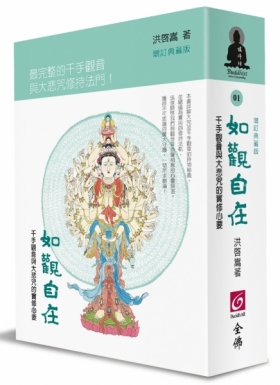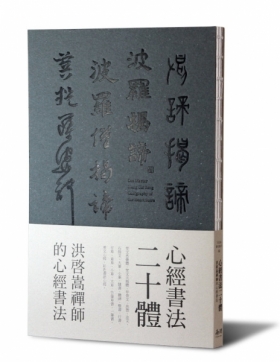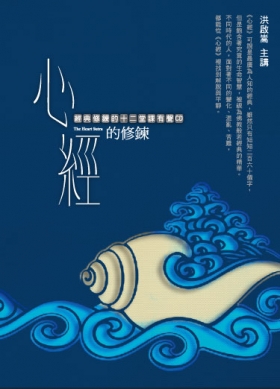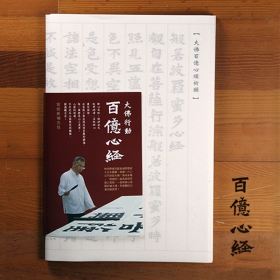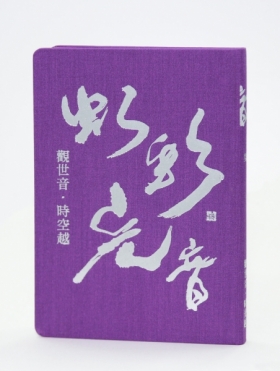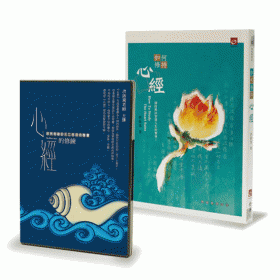“The Wisdom-seeking process is like trying to cap a bottle in the dark.
We try to find the bottle but we cannot see any thing.
Finally, we cap the bottle and turn it tight.
When you cap the bottle, the bottle will grab the cap.
When you are controlled by the outside realm; you can not freely use your wisdom.
If you want to escape being tied to each other, you have to turn open the cap one more time, and, this time, turning the cap is giving up your self and the arrogance of knowledge.”
(The Sutra of My Heart—Sending you a Song for Crossing the River, Hung Chi-Sumg)
「追求智慧的過程,就像在黑暗中要將瓶蓋合上瓶身,
在伸手不見五指的黑暗裡,不斷摸索著、試探著,
最後終於把瓶蓋合上瓶身,然後再把它旋緊。
可是,當你把瓶蓋拴緊在這個瓶罐上時,
瓶身同時也抓牢了瓶蓋。
當你被境界所控制,就不能自由自在地運用智慧。
想要脫離這個相互套牢的狀態,
必須再一次把蓋子旋出來——
這旋出來的蓋子,就是你要放棄的自我,知識的傲慢。」
—摘自《The Sutra of My Heart—Sending you a Song for Crossing the River》
The Heart Sutra, in just 260 words, it is full of the ultimate wisdom of life.
People of different eras, facing different changes, chaos, and sufferings, can find relief and peace from the Heart Sutra. This is the reason why the Heart Sutra transcends religions and regions and is widely recited by people from all walks of life.
"The Sutra of My Heart—Sending you a Song for Crossing the River" is Master Hung Chi-Sung's interpretation from a never-seen-before perspective, and gives a fresh presentation of the Heart Sutra in the form of prose. Furthermore, he also provides a beautiful English translation of the classic Heart Sutra.
This book combines text and painting. The paintings painted by the author in meditation are like the scenery along the river of life. All phenomena are constantly changing. They can be aggregated or decomposed. There is no "beginning" and no "ending". If we awaken to the emptiness of all existences, and are not controlled by the inertia of life, it is like waking up from a dream, filled with the joy of freedom.
Let life reach the true, free, other shore! The shore of enlightenment is in this life, and is not the ending; it is the beginning.
《心經》,短短二百六十個字,飽含著究竟的生命智慧。
不同時代的人,面對不同的變化、混亂、苦難,都能從《心經》裡找到解脫與平靜。這正是《心經》超越宗教與地域,廣為各方人所誦讀的原因。
《The Sutra of My Heart—Sending you a Song for Crossing the River》,是洪啟嵩禪師以前所未見的角度來詮釋、解讀,並且以散文的形式重新呈現《心經》,同時作者也為經典《心經》作出精彩的英文翻譯。
本書結合文字與繪畫,一幅幅作者於禪定中所繪的畫作,宛如生命之河沿途的風景,所有現象不斷地在變化,可以聚合亦可以分解,沒有「生起」,也沒有「消滅」。當我們體會宇宙萬象的空性,不被生命慣性所制約,就如同從夢中醒來,充滿自在的喜悅。
讓生命抵達最真實、最自在、最圓滿的「彼岸」吧!「彼岸」就在今生,不是終點,而是起點。
《The Sutra of My Heart》Foreword
—Lyonpo Dr. Kinzang Dorji (Former Prime Minister of Bhutan)
I remember from my childhood days when lay monks would be invited to our house to recite Sherab Nyingpo or the Heart Sutra whenever advised by Lams or astrologers to overcome difficult times such as sickness in the family. This practice continues to this day not only in my household but in almost every Bhutanese household. But I was to understand the origin and real meaning of the Sutra only much later in my life. It was in 2010 on a pilgrimage with my family to Buddhist holy sites in India when I was able to visit the Vulture’s Peak or Vulture Flock Mountain in Rajagriha, now known as Rajgir, where this Sutra of Sutras or the essence of all of Buddha’s teachings was first delivered. Rajgir is also considered as one of the eight holiest Buddhist sites since it was here Buddha delivered his second sermon or the second turning of the wheel of Dharma took place. It was an experience of extraordinary feeling being able to share this exclusive space with pilgrims from many countries such as Korea, Thailand, Japan and India and recite the Heart Sutra which was born on this very holy site.
Master Hung Chi-Sung enjoys tremendous respect as a writer, painter, and internationally renowned scholar of Buddhism and meditation. Amongst his follower-students in Taiwan are seasoned politicians from across party lines, top business tycoons, academics and bureaucrats. So, I wholeheartedly welcome Master Hung’s initiative to get his book, “The Sutra of My Heart” published in Bhutan, the last Mahayana Buddhist Kingdom, where His Majesty Jigme Singye Wangchuck, the extraordinary 4th King of Bhutan, gave birth to the wise and profound philosophy of Gross National Happiness which is now the guiding principle and objective for Bhutan’s development path to its future. Master Hung’s book can not only help us to understand the true essence of our state religion, Buddhism, better but it can also help us to attain our overarching national goal of Gross National Happiness. I recommend this book to every Bhutanese and wish everyone a happy reading.
《The Sutra of My Heart》Author's Preface
We humans carry all kinds of physical and psychological pressure, from outside and inside. In our modern age, especially in the twenty-first century, however, our burdens and misery have intensified. All too many factors, all too many concerns like air, water, sunshine, food, education, the economy, and so on—all these worries make it difficult to breathe.
The more we try through various ways to throw off these burdens and cast away this misery, the more tangled up we feel. We possess more and more information, but this just leads us to confuse the true with the false. We get all muddled up, unable to judge or choose, and, in turn, we need even more information; a vicious cycle.
Simply put, information, knowledge and wisdom are not the same. If the mind does not have inner peace, whatever information we receive will not become useful knowledge or grow into wisdom. Worse yet, it will lead to information anxiety. The source of this dilemma lies in the turmoil of our minds: the space in our hearts and minds has become too small, even non-existent.
The Heart Sutra, the most popular and well-known sutra in China, entered common lore long ago and became familiar to all. With only 260 characters in the Chinese text, the sutra is extremely condensed and easy to recite by heart. Though short, the Heart Sutra is the essence of the vast, systematic wisdom of the Prajña Sutras.
The Heart Sutra’s full title is the Prajñā Pāramitā-Hrdaya Sūtra, which means “the sutra within the heart of the perfect wisdom”. In other words, the sutra serves to help us grasp the spirit of the immense Prajña. We use the wisdom in the Heart Sutra to overcome all suffering and to arrive successfully at the other shore. So the Heart Sutra can be called the Essential Core within the Way of the Mind. Easy to remember and easy to recite, the sutra is a superb guide for practice, whether for ordinary people or practitioners of Buddhism.
The Heart Sutra helps us become a “Freeness-of-Vision Bodhisattva” .The sutra is a key that helps us become completely enlightened like Buddha.
Ordinary folks often see Buddha as a superior being, beyond their reach, or else as an object of worship. Worshiping Buddha takes the place of learning from Buddha. Learning from Buddha means following the correct path to become enlightened, to become Buddha. Worshiping Buddha can start this learning process, but we must afterwards strive to understand Buddha and Buddha's heart, to experience them and to put them in practice, just like Buddha. If we only believe in Buddha blindly, as someone to rely on, then Buddhism is no different from any other religion.
Let us step back and think: Why did Sakyamuni say that his method of intuition and practice can be learned by anyone, anytime, anywhere? Because the essence of Buddhism, the inner truth of Buddhism, does not change, because it lies beyond language, beyond conscious structures of thought; neither time, space, nationality, nor even intelligence, limits its reach.
What matters most in Buddhism is not how much Buddhist jargon you have learned or how many sutras you have read, but how well you have put what you have understood and experienced into practice and into action in everyday life. Then we merge naturally into living the way of Buddha. We should not treat Buddhism as merely some sort of intellectual pursuit or as rules of behavior. To study and learn broadly is certainly useful and, with the help of sutras, we will further our practice of Buddhism. The finger points at the Moon, but the finger is not the Moon.
To clear away our worries, we must let the heart and mind take charge. We must be guided by our original heart; not by our worries or troubles. Once the heart and mind hold sway, our six sense organs—the eye, the ear, the nose, the tongue, the body, and awareness—will have proper guidance. All sensations and information can then enter from the outside, and our six sense organs will take their rightful place and fulfill their proper roles, naturally and effortlessly. Buddhism allows us to expand the space of the heart; as the space of the heart expands, we become ever more free. Problems we face will be overcome with ease instead of getting stuck in a rut.
What is more, the heart relaxes, breathing relaxes, and then the body relaxes. Our body and mind’s well-being must surely improve; we become gentle and in harmony with everything outside of us. From then on, living becomes a virtuous cycle and transforms the surrounding environment.
The paintings in this book were done when I was carefree and relaxed, which is my natural condition. This is my first work with painting as the main theme. I have occasionally, in the past, picked up a brush and written some calligraphy naturally, but I have never studied calligraphy nor have I undergone formal training. I only wrote a few characters, following my heart.
Because my body and mind have long been relaxed, I sensed the growing suppleness of the brush in my hand. It felt as though the brush merged with my hand, merged with my heart: everything was united and one. Even the ink and the paper felt at one with my body. My hand, my heart, my calligraphy, my paintings—everything became one. I had great joy when painting and doing calligraphy.
At the beginning, painting simply felt comfortable; it made me happy, carefree, at ease. When I saw something, I would paint it.
First I painted images of Buddhas and Bodhisattvas. I do not remember clearly when I began painting other things, so it must have been a natural progression. When I painted in my leisurely way, I only wanted to portray the manifestation of utmost truth and beauty in this world: I painted Buddhas and Bodhisattvas this way and I painted everything else this way.
Whenever I saw a child, I would paint the child as a little Buddha. Even flowers and animals, I wanted to portray as Buddhas, as expressions of the complete perfect life. Painting like this always gave me a profound sense of joy.
I made posters of my baby Buddhas. Luckily they were laminated because, as I later discovered, a lot of children would touch them and kiss them, and they became wet from their kisses. I was astonished. I thought, “Wow, the children actually like my paintings this much!” Knowing that the children loved the pictures and that the pictures could speak to the pure innocence of their hearts made me very happy: I felt I had accomplished a great thing.
So my heart and my hand became freer; even more carefree. Since I could speak to the children, I could speak to the mountains, rivers, the ground, flowers, grass, dogs and cats. I could converse with them. I could see their original hearts, their pure innocence. They show these naturally.
More and more relaxed, I saw everything as a child. It is like water bubbling up out of the ground. This made me joyful. And so I always carried a pen, a brush, or a pencil. I even drew with an eyebrow pencil. I would take hold of anything at all and draw on it whatever came naturally. My book Love Catch 22 was painted like this.
Words can explain more clearly the deeper meaning beneath the surface of a text and lay out the ideas in an orderly manner; words allow us to understand the system of thought. Modern people have had training in logic. Sometimes this training is a barrier to understanding. Not so with a painting.
Let me give you an example. In 2004, I lectured on Relaxation Zen at Harvard University for the first time. At that time I spoke in Chinese which was simultaneously translated into English for the benefit of the audience. The interpreter did not really understand what I said. Afterwards some of my students had to explain the contents of my talk. Among those present was an elderly Harvard professor whose remarks made a deep impression on me. He said that he had understood. He had not needed words; he saw my body, my movements, how I carried myself, and understood the essence.
Sometimes there are things that cannot be fully explained, however many complicated words are used. But with a brush-stroke, with a painting, everything becomes clear.
Once, an American entrepreneur from Silicon Valley happened to see my 15-foot-high calligraphy consisting of the Chinese character which means Buddha. He was deeply touched. He told me he did not only see the character for Buddha, but he also saw his own body relaxed. At that moment, his body was warm and his body and mind were refreshed.
It does not matter how much we explain release, relaxation, emptiness; the people listening might not always understand. But when we look at a painting, when we see the lines and colors, we feel life's relaxation and harmony. We might get something out of that.
A painting can help your breathing relax and adjust. And when your heart has relaxed, you see things more clearly and spiritually. Actually all of my paintings are connected directly with my heart. Paintings might not seem to say anything in particular when compared to words, and yet they are felt more directly and thus express more; they touch the inner heart all the more deeply.
So what is the relationship between the Heart Sutra and this state of body and heart relaxation?
The Heart Sutra starts with:
The Freeness-of-Vision Bodhisattva enlightens all and saw through the five skandhas, which were empty, while living in complete transcendental wisdom, and, so, is beyond all suffering.
When we “enlighten all and see through the five skandhas”, our bodies and minds will naturally release and relax without attaching to anything, and we will be able to be “beyond all suffering” and free from all our worries. “See through the five skandhas, which were empty” is to see that the five skandhas (our bodies, feelings, thoughts, desires, and awarenesses) are things that cannot be attached to. They are empty. Doing that will create an unobstructed wisdom that helps us be beyond all suffering and hardship.
The basic theory of Relaxation Zen, which I created, is the wisdom of emptiness in the Heart Sutra.
Whenever we practice, we let the six sense organs—the eyes, the ears, the nose, the tongue, the body, and awareness—release and relax. We always keep our body and mind aware. We must not attach to the environment. Our hearts will not chase after something that looks good, tastes good or sounds good. If our six sense organs, and hearts do not follow the environment, if we always see it with our awareness, then we will become a Freeness-of-Vision Bodhisattva.
The Sutra of My Heart greets the world with a new face for the Heart Sutra. I hope all of us in the modern age will freely take and absorb from the wonderful source of wise spring water of the Heart Sutra.
Whether in the past, in the present, or in the future, the wisdom of the Heart Sutra will help our lives move towards a bright happiness.
In November 2008, I was invited to teach Relaxation Zen at the Massachusetts General Hospital. The Massachusetts General Hospital is one of the most famous hospitals in the United States.
Many of the scientists there, after hearing about Relaxation Zen, believed it may very well be a good way to maintain the physical and mental health of people.
Ever since 2009, I have been collaborating with researchers at the Massachusetts General Hospital / Harvard Medical School on the study of meditation using functional neuroimaging. The Massachusetts General Hospital is one of the best hospitals in the world, many of the scientists there believe that meditation is a good way to maintain the physical and mental health of people.
Humanity is fast diving into the space age. Life on planet Earth will one day reach life on other planets in the universe. Will the future be an era of “Star Wars” or an age of universal well-being? We must make the right choices now.
My greatest wish in life is to help every being open up the light of awareness. This, I believe, is also the greatest meaning of life. I pray that everyone becomes an “Earth Zen Person” and, using the Earth as the center, lets the bright light of wisdom go to the furthest reaches of the universe, in a message of peace. May the Earth's wellness spirit be offered to the universe. May this Sutra of My Heart become the most beautiful song in the universe and be sung forever!
《The Sutra of My Heart》About the Author
Ven. Master Hung Chi-Sung
International Zen Master
Committee Director of General of Academic of Chinese Buddhist Association
Distinguished Professor of Chung Hua University.
Artist of "Great Buddha", Guinness World Record's
World's Largest Painting.
Ven. Master Hung Chi Sung is an internationally acclaimed Zen Master, Zen artist, and bestselling author renowned for his profound impact on Zen practice, art, and literature. With a prolific literary output of more than 300 books, he is frequently hailed as the "Michelangelo of the 21st century" and esteemed as the "contemporary Kukai". He currently holds key positions, including Director-General of the Academic Committee of the Chinese Buddhist Association, Distinguished Professor at Chung Hua University, and Chief Advisor of the Yungang Grottoes Research Institute.
Master Hung was invited to Taiwan, America, China, and Europe to lead retreats and give lectures in both Chinese and English, including Harvard University, MIT, Chinese Academy of Social Sciences, Beijing University, and Fudan University in China, and Taiwan University, and so on.
In 2018, Master Hung finished the largest painting of Buddha in the world (168mX72.5m). The painting is twice the height of the Grand Hotel in Taipei. This painting received the Guinness World Record for the largest painting in the world on June 21, 2019.
Notable Honors:
2009: Certificate of Honor by City of San Francisco for contribution to Zen meditation
2010: Certificate of Honor by the Kingdom of Bhutan for Bodhisattva economics
2019: World’s largest painting certified by The Guinness World Records


